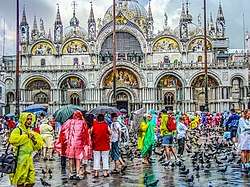Urban wildlife
Urban wildlife is wildlife that can live or thrive in urban environments. Some urban wildlife, such as house mice, are synanthropic, ecologically associated with humans. Some species or populations may become entirely dependent on humans. For instance, the range of many synanthropic species is expanded to latitudes at which they could not survive the winter outside of human settlements. Other species simply tolerate cohabiting with humans and using the remaining green spaces, in some cases gradually becoming more accustomed to the new habitat over time and eventually synanthropic. These species represent a minority of the creatures that would normally inhabit an area. For example, a 2014 compilation of studies found that only 8% of native bird and 25% of native plant species were present in urban areas compared with estimates of non-urban density of species.[1]
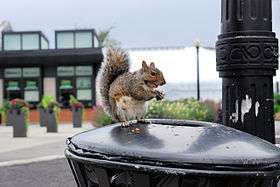
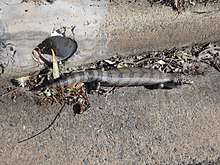
Urban wildlife can be found at any latitude that supports human dwellings - the list of animals that will search human trash within settlements runs from tropical monkeys to polar bears in the Arctic.
Different types of urban areas support different kinds of wildlife. One general feature of bird species that adapt well to urban environments is they tend to be the species with bigger brains, perhaps allowing them to be more adaptable to the changeable urban environment.[2]
Evolution
Urban environments can exert novel selective pressures on organisms sometimes leading to new adaptations. For example, the weed Crepis sancta, found in France, has two types of seed, heavy and fluffy. The heavy ones land near the parent plant, whereas the fluffy seeds float further away on the wind. In urban environments, seeds that float far often land on infertile concrete. Within about 5-12 generations the weed has been found to evolve to produce significantly more heavy seeds than its rural relatives.[3][4] Among vertebrates, a case is urban great tits, which have been found to sing at a higher pitch than their rural relatives so that their songs stand out above the city noise, although this is probably a learned rather than evolved response.[5][6] Urban silvereyes, an Australian bird, make contact calls that are higher frequency and slower than those of rural silvereyes. As it appears that contact calls are instinctual and not learnt, this has been suggested as evidence that urban silvereyes have undergone recent evolution so as to better communicate in noisy urban environments.[7]
Broadly distributed
Some urban species have a cosmopolitan (i.e. nonselective) distribution, in some cases almost global. They include house mice, cockroaches, silverfish, black rats, brown rats, house sparrows, rock doves, and feral populations of domestic species.
Africa
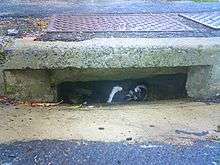
As Africa becomes increasingly urbanized, native animals are exposed to this new environment with the potential of uniquely African urban ecologies developing. In the Cape Town urban area in South Africa, there is increasing conflict between human development and nearby populations of Chacma baboons due to baboons growing dependence on tourists and the urban environment as sources of food.[8] Elsewhere in Africa, vervet monkeys as well as baboons adapt to urbanization, and similarly enter houses and gardens for food. African penguins are also known to invade urban areas, searching for food and a safe place to breed. Simon's Town, next to the popular Boulders Beach had to take action to restrict penguin movement due to the noise and damage they caused.[9] There are reports of leopards roaming suburban areas in cities such as Nairobi, Kenya and Windhoek, Namibia. Reptiles like the house gecko (Hemidactylus) can be found in houses.
Australia
Urban areas in Australia are a particularly fruitful habitat type for many wildlife species. Australian cities are hotspots for threatened species diversity and have been shown to support more threatened animal and plant species on a per unit-area basis than all other non-urban habitat types.[10] An analysis of urban sensitive bird species (birds that are easily disturbed and displaced) found that revegetation was effective at encouraging birds back into urban greenspaces, but also found that weed control was not. Invasive plant species such as Lantana (L. camara) actually provides refuge for some bird species such as the superb fairy (Malurus cyaneus) and silvereye (Zosterops lateralis), in the absence of native plant equivalents.[11] Some species of native animals on Australia, such as various bird species including Australian magpies, are able to survive as urban wildlife,[12] although introduced birds are more common in the centre of larger cities. Some of the most adaptable small marsupial species, including the Northern brown bandicoot, have also adapted to the urban environment.[13] This being said there are many threats to urban areas in Australia such as habitat loss and fragmentation, invasive species (such as cats and Indian mynas), pest species (such as noisy miners), weed propagule pressure, other disturbance, that accompany intensive human land use.[14] If biodiversity is to flourish in urban areas, efforts at the community scale thorough initiatives such as Land for Wildlife and private land conservation, as well as policy and management efforts through restricting land clearing and providing incentives to retain nature in cities is needed.
Japan
Although culled aggressively in most of Japan for being a pest, the Sika deer is, for religious reasons, protected in the city of Nara and has become part of the urban environment.[15] Due to the denseness of Japanese cities, birdlife is not as common as other parts of the world, though typical urban birds such as crows, sparrows, and gulls have adapted well.[16]
Hawaii
The urban birdlife of Hawaii is dominated by introduced species, with native species largely remaining only in preserved areas.[17]
New Zealand
The birdlife in the most urban parts of New Zealand is dominated by introduced species, with bush fragments in the less urbanized areas allowing native species to cohabit.[18][19]
India
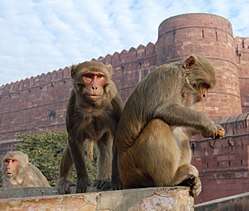
In India, the situation is similar to Africa. Monkeys, such as langurs, also enter cities for food, and cause havoc in food markets when they steal fruit from the vendors. In Mumbai, leopards have entered neighbourhoods surrounding the Sanjay Gandhi National Park and killed several people, as the park itself is besieged by a surrounding burgeoning population, where poaching and illegal woodcutting is rife.[20]
Europe
Many towns in the United Kingdom have Urban Wildlife Groups that work to preserve and encourage urban wildlife. One example is Oxford.[21]
Outside
Urban areas range from fully urban – areas having little green space and mostly covered by paving, tarmac, or buildings – to suburban areas with gardens and parks. Pigeons are found scavenging on scraps of food left by humans and nesting on buildings, even in the most urban areas, as the tall buildings resemble their natural rocky homes in the mountains. Rats can also be found scavenging on food. Gulls of various types also breed and scavenge in various U.K. cities. A study by the bird biologist Peter Rock, Europe's leading authority on urban gulls, into the rise of herring gulls and lesser black-backed gulls in Bristol has discovered that in 20 years the city's colony has grown from about 100 pairs to more than 1,200. From a gull's point of view, buildings are simply cliff-sided islands, with no predators and lots of food nearby. The trend is the same in places as far apart as Gloucester and Aberdeen. With an endless supply of food, more city chicks survive each year, and become accustomed to urban living. They in turn breed even more birds, with less reason to undertake a winter migration.[22]
Waterfowl such as Ducks, Coots, Geese, Swans, and Moorhens thrive in gardens and parks with access to water. Small populations can form around fountains and other ornamental features, far from natural bodies of water, provided there are adequate amounts of food such as aquatic plants growing in the fountain.
From a study conducted on Great Tits living in 10 European cities and in 10 nearby forests. An analysis was made of the way the birds used songs to attract mates and establish territorial boundaries. Hans Slabbekoorn, of Leiden University in the Netherlands, said that city birds adapt to life by singing faster, shorter, and higher pitch songs in the cities compared to forests. The forest birds sing low and they sing slow. Great Tits living in noisy cities have to compete with the low-frequency sounds of heavy traffic, which means their songs go up in pitch to make themselves heard.[23] A bird that sang like Barry White in the forest sounded more like Michael Jackson in the big city.[24]
The advent of these animals has also drawn a predator, as Peregrine falcons have also been known to nest in urban areas, nesting on tall buildings and preying on pigeons.[25] The peregrine falcon is becoming more nocturnal in urban environments, using urban lighting to spot its prey. This has provided them with new opportunities to hunt night-flying birds and bats. Red foxes are also in many urban and suburban areas in the U.K. as scavengers.[26] They scavenge, and eat insects and small vertebrates such as pigeons and rodents. People also leave food for them to eat in their gardens. One red fox was even found living at the top of the then-partially completed Shard in 2011, having climbed the stairwell to reach its temporary home some 72 stories above ground.[27]
In some cases even large animals have been found living in cities. Berlin has wild boars.[28] Wild roe deer are becoming increasingly common in green areas in Scottish towns and cities, such as in the Easterhouse suburb of Glasgow.[29] Urban waterways can also contain wildlife, including large animals. In London, since improvements in water quality in the Thames, seals and porpoises have been seen in its waters in the center of the city .
Close proximity to avian life hasn't presented a problem for people in the past, but there are new concerns about the spread of bird flu (the H5N1 virus) via infected migratory birds. Some scientists are worried that persistent human expansion could indirectly lead to a disease pandemic of global proportions.[30]
Inside houses
Numerous animals can also live within buildings. Insects that sometimes inhabit buildings include various species of small beetles such as ladybirds, which often seek refuge inside buildings during the winter months,[31] as well as cockroaches. See also housefly.
North America
Many North American species have successfully adapted to urban environments and are thriving. Typical examples include coyotes, the top predator of such regions. Other common urban animals include: predators such as red foxes, grey foxes, and bobcats that prey on small animals such as rodents. Omnivores such as raccoons, Virginia opossums, and striped skunks are seldom seen and mainly come out at night; In the south and southeastern United States and Mexico the nine-banded armadillo joins these other omnivores but due to the armadillo's lack of thick fur they are unable to thrive in more northern climates. Squirrels, including the American red squirrel, fox squirrel, and eastern grey squirrel are extremely common in suburbs with enough trees. Herbivores forage in the early morning and evening with cottontail rabbits and in dryer parts of the country jackrabbits as well as the two most common deer species in North America the white tailed deer and the mule deer. Shy of humans, deer are often spotted as a mother with fawns or a lone buck creeping through the trees and bushes. As whitetails prefer forest edge and meadow to actual dense forest, the cutting of forests has actually made more habitat for the white-tailed deer, which has increased its numbers beyond what they were at when Europeans arrived in America. In some cities, older deer seem to have learned how to cross the street, as they look back and forth looking for cars while crossing roads, while fawns and younger deer will recklessly run out without looking; most traffic accidents involving deer happen with deer that have just left their mother, and are less likely to watch for cars.
Red-tailed hawks such as Pale Male have been documented nesting and raising chicks in New York City since at least the 1990s.
The American alligator, a once-threatened species that was saved from extinction through farming and conservation, can frequently be found living in open areas with access to water, such as golf courses and parks, in its native range.[32][33]
These animals living in urban areas sometimes come into conflict with humans, as some of them will open garbage bags in search of food, eat food left out for pets, prey on unattended pets, feed on prized garden plants, dig up lawns or become traffic hazards when they run out into the road. Coyotes pose a risk to small children, who should not be left unsupervised in areas that coyotes are known to inhabit; they are large enough to easily kill and eat a child, and they lack the fear of humans that most wild canids exhibit. While there are media accounts of alligators being found in sewer pipes and storm drains, most experts think that such 'sewer alligators' are unlikely to sustain a breeding population in such environments, due to a lack of place to bury their eggs. Urban wildlife is often considered a nuisance, with local governments being tasked to manage the issue.[34]
In 2009, a large blobby mass made of colonies of tubifex worms was found to be living in the sewers of Raleigh, North Carolina. Revealed by a snake camera inspection of sewer piping under the Cameron Village shopping center, videos of the creature went viral on YouTube in 2009 under the name "Carolina poop monster".[35]
Animals known to dwell within human habitations in the US include house centipedes (Scutigera coleoptrata), and firebrats.[36]
South America
Marmosets can be found living wild in city parks in Brazil.[37] Urban-dwelling marmosets tend to return more often to the same sleeping sites than jungle-dwelling marmosets. Urban-dwelling marmosets tend to prefer to sleep in tall trees with high first branches and smooth bark. It has been suggested they do this to avoid cats.[37]
See also
References
- Aronson, Myla F. J.; La Sorte, Frank A.; Nilon, Charles H.; Katti, Madhusudan; Goddard, Mark A.; et al. (April 2014). "A global analysis of the impacts of urbanization on bird and plant diversity reveals key anthropogenic drivers". Proceedings of the Royal Society B. 281 (1780): 20133330. doi:10.1098/rspb.2013.3330. PMC 4027400. PMID 24523278.
- Davies, Ella (2011-04-27). "Adaptable urban birds have bigger brains". BBC News. Retrieved 2013-06-18.
- "Evolution in the urban jungle". The Oyster's Garter. 2008-03-12. Archived from the original on 2010-12-03. Retrieved 2013-06-18.
- Cheptou, P.; Carrue, O.; Rouifed, S.; Cantarel, A. (2008). "Rapid evolution of seed dispersal in an urban environment in the weed Crepis sancta". Proceedings of the National Academy of Sciences. 105 (10): 3796–3799. doi:10.1073/pnas.0708446105. PMC 2268839. PMID 18316722.
- "The urban evolution lab". New Scientist. April 19, 2006. Retrieved 2013-06-18.
- Slabbekoorn, Hans; Peet, Margriet (July 2003). "Ecology: Birds sing at a higher pitch in urban noise". Nature. 424 (6946): 267. doi:10.1038/424267a. PMID 12867967.
- Zukerman, Wendy (2011-01-07). "Hipster bird species evolving to tune out urban sounds". New Scientist. Retrieved 2013-06-18.
- Cruise, Adam (22 April 2016). "Is This the End For South Africa's Famed Urban Baboons?". National Geographic. Retrieved 25 November 2016.
- "The African Penguin". simonstown.com. Retrieved 2008-11-19.
- Ives, Christopher D.; Lentini, Pia E.; Threlfall, Caragh G.; Ikin, Karen; Shanahan, Danielle F.; Garrard, Georgia E.; Bekessy, Sarah A.; Fuller, Richard A.; Mumaw, Laura (2016-01-01). "Cities are hotspots for threatened species". Global Ecology and Biogeography. 25 (1): 117–126. doi:10.1111/geb.12404. ISSN 1466-8238.
- Archibald, Carla L.; McKinney, Matthew; Mustin, Karen; Shanahan, Danielle F.; Possingham, Hugh P. (2017-06-01). "Assessing the impact of revegetation and weed control on urban sensitive bird species". Ecology and Evolution. 7 (12): 4200–4208. doi:10.1002/ece3.2960. ISSN 2045-7758. PMC 5478067. PMID 28649333.
- "Birds in Backyards: Top 30 Urban Birds". Australian Museum. 30 October 2015. Retrieved 26 November 2016.
- Fitzgibbon, S.I. (2010). "The behavioural ecology and population dynamics of a cryptic ground-dwelling mammal in an urban Australian landscape". Austral Ecology. 36 (6): 722–732. doi:10.1111/j.1442-9993.2010.02209.x.
- Heinrichs, Steffi; Pauchard, Aníbal (2015-10-01). "Struggling to maintain native plant diversity in a peri-urban reserve surrounded by a highly anthropogenic matrix". Biodiversity and Conservation. 24 (11): 2769–2788. doi:10.1007/s10531-015-0964-y. ISSN 0960-3115.
- Solbig, Zachary (4 February 2015). "The Wild Deer That Roam a Japanese City's Streets". Wired. Retrieved 27 November 2016.
- Higuchi, Hiroyoshi (2014). Natural History of Japanese Birds (PDF). Tokyo: Heibonsha.
- "Wildlife". Department of Land and Natural Resources, Hawai‘i. Retrieved 26 November 2016.
- van Heezik, Yolanda; Smyth, Amber; Mathieu, Renaud (2008). "Diversity of native and exotic birds across an urban gradient in a New Zealand city". Landscape and Urban Planning. 87 (3): 223–232. doi:10.1016/j.landurbplan.2008.06.004.
- "Identifying New Zealand Birds". New Zealand Backyard Birds. Retrieved 27 November 2016.
- Sears, Stephanie. "Mumbai Leopards: Killers or Victims?". Wildlife Extra News. Retrieved 2013-06-18.
- "OUWG". Oxford Urban Wildlife Group. Retrieved 2013-06-18.
- Kelbie, Paul (2003-05-20). "Gulls adapt to urban life in search for top pickings". The Independent. London. Retrieved 2010-05-27.
- Connor, Steve (2006-12-05). "How city birds adapt to life in the fast lane". The Independent. London. Retrieved 2010-05-27.
- Cutraro, Jennifer (4 December 2006). "City Bird, Country Bird". ScienceNOW. Retrieved 2013-06-18.
- Unwin, Brian (2008-02-06). "Peregrine falcon adapting to urban lifestyle". The Daily Telegraph. London. Retrieved 2010-05-27.
- Foxes Archived February 24, 2008, at the Wayback Machine
- "Fox lived in the Shard skyscraper at London Bridge". BBC News. 2011-02-24.
- "Berlin suffers wild boar invasion". BBC News. 2011-05-01.
- Williams, Huw (2011-07-12). "My heart's in the High Street a'chasing the deer". BBC News. Retrieved 2013-06-18.
- "Human population growth, migratory birds and the spread of disease". Ashland Daily Tidings. January 27, 2010. Retrieved 2013-06-18.
- "10 of the bugs and insects that will be living in your house this winter". Irish Examiner. 20 November 2015. Retrieved 27 November 2016.
- AR Woodward & DN David. "Alligators". The Internet Center for Wildlife Damage Management. Retrieved 27 November 2016.
- "Orlando Alligator Facts & Information". Nationwide Wildlife Removal. Retrieved 27 November 2016.
- Schramm, Jill (5 October 2017). "Committee to consider urban hunting, ban on feeding wildlife". Minot Daily News. Minot. Retrieved 6 October 2017.
- "Sewer creature mystery solved". Wired. July 2009.
- Archived March 10, 2009, at the Wayback Machine
- Davies, Ella (2010-12-28). "Urban marmosets avoid pet threat". BBC News.
External links
- Wild in the City, a National Film Board of Canada documentary on urban wildlife in Vancouver
- Luniak, Maciej (2004). Synurbization—adaptation of animal wildlife to urban development (PDF). The 4th International Symposium On Urban Wildlife Conservation. CiteSeerX 10.1.1.122.3057.
